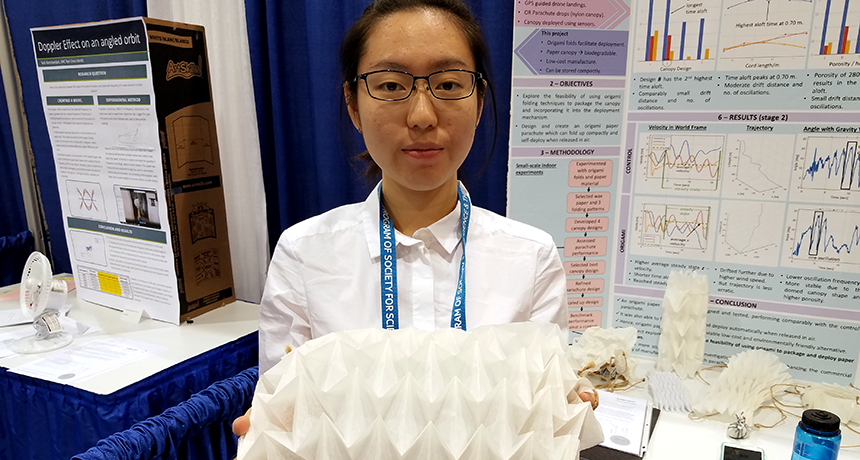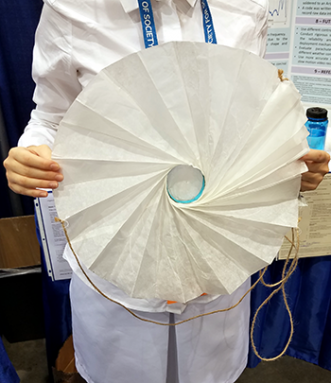How to develop more ecofriendly parachutes for disaster relief
Make them out of paper, and give them origami folds

Natalie Yam displays a small-scale model of her new parachute model made from folded paper.
A.S. Perkins
By Sid Perkins
PHOENIX, Ariz. — The centuries-old Japanese art of paper-folding could help make modern disaster-relief efforts a little more ecofriendly. Known as origami, the folded paper parachutes could deliver light packages of supplies to remote regions, suggests its 18-year-old inventor from Singapore.
Many disaster-relief programs deliver tons of supplies, such as food, water or heavy equipment. These tend to be moved by road on big trucks. But some supplies may weigh just a few kilograms (pounds) or less. One such parcel, for instance, might contain a few doses of some lifesaving medicine, explains Natalie Yam. She’s a 12th grader at the Anglo-Chinese School in Singapore. Increasingly, she notes, drones deliver such small packages.

But the parachute that ferries these parcels to the ground from helicopters or planes often are made of nylon. After a single use, such parachutes almost always are discarded. And because nylon is a polymer made from crude oil, it doesn’t decompose quickly (if ever). So, Natalie looked for a greener alternative.
Nylon is strong. But a parachute used just once for light packages doesn’t have to be that strong. Paper might be good enough, the teen thought. Plus, a chute made of paper can be folded into a tiny bundle, just as a fabric parachute can. Moreover, she notes, origami provides many different ways to fold the unopened paper chute.
Natalie came up with several folded designs, then tested them. Her first models were small, so she could test them indoors. Two were round. Two more were rectangular. One of the rectangular ones opened most smoothly, she found. It also was the slowest to fall and the most stable as it dropped through the air. Such features can be important when the goal is delivering some parcel to the ground softly and on target, she says.
She made a larger model of her best design and tested it outdoors. Instead of carrying a parcel, this chute carried an instrument that could actually measure the parachute’s speed and stability. This larger version of the parachute measured about 184 centimeters (6 feet) by 82 centimeters (almost 3 feet). During her tests, the chute dropped about 1.2 meters per second. That sounds fast, but isn’t too fast if the parcel it carries is well padded, the teen notes.
Natalie showcased her designs here, this week, at the Intel International Science and Engineering Fair. The competition was created by Society for Science & the Public in 1950. The 2019 event brought together more than 1,800 finalists from 80 countries. (The Society also publishes Science News for Students.)
Natalie’s single-use paper chutes should decompose easily. That means they shouldn’t be bad for the environment. They also should be less costly than parachutes made out of more conventional materials. A nylon parachute the size of her design would cost about $31, she says. One made from silk, another common parachute fabric, would cost almost $16. But an origami chute made from paper will likely cost less than $1, Natalie estimates.








